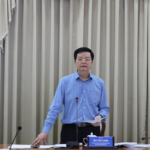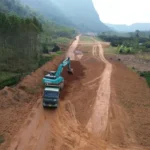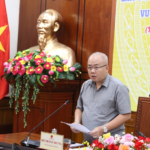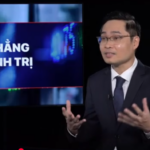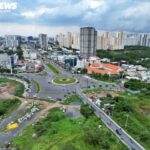In the afternoon of June 16, Deputy Prime Minister Tran Hong Ha chaired a hybrid meeting with ministries, sectors, and localities regarding site clearance for the North-South high-speed railway project.
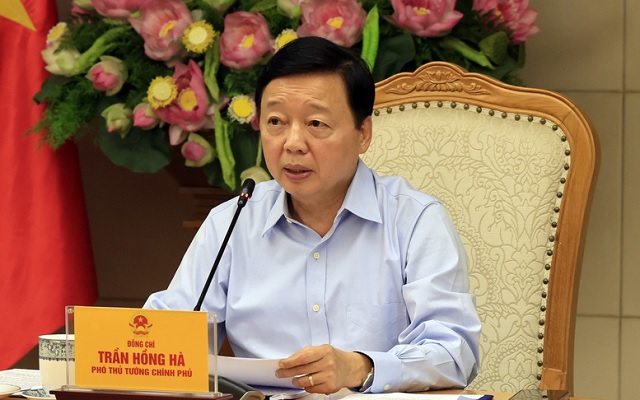
In the afternoon of June 16, Deputy Prime Minister Tran Hong Ha chaired a hybrid meeting with ministries, sectors, and localities regarding site clearance for the North-South high-speed railway project – Photo: VGP/Minh Khoi
|
The Deputy Prime Minister emphasized that the National Assembly has agreed to separate the site clearance for the North-South high-speed railway project into an independent project to ensure proactive and timely implementation. The Ministry of Construction, in coordination with the Ministry of Agriculture and Environment and local authorities, is assigned to carry out this task.
According to the Deputy Prime Minister, the North-South high-speed railway project is a strategic task with significant implications for socio-economic development and regional connectivity. Therefore, the preparation, especially site clearance, needs to be conducted urgently, systematically, and in compliance with regulations.
Instructions from the Politburo, the Government Party Committee, and the Government Standing Committee stipulate that site clearance, including resettlement issues, must commence in August 2025 as the initial step for the North-South high-speed railway project.
“Time is limited, and ministries, sectors, and localities must have specific and detailed plans regarding progress and tasks, while also reporting any existing difficulties for timely handling,” said the Deputy Prime Minister, emphasizing that local authorities are the main force in implementing the site clearance project.
However, to enable local authorities to perform effectively, it is essential to ensure sufficient legal and technical conditions, especially regarding central-level competencies such as converting forest and rice land use purposes, and infrastructure planning. Any remaining obstacles must be promptly reported for resolution.
Site clearance dossiers have been handed over to local authorities
The Ministry of Construction, the Ministry of Agriculture and Environment, and relevant ministries and sectors need to provide guidance and clarify procedures related to compensation, resettlement, and new residential area arrangements to ensure a smooth and consensual process during the mobilization and relocation of residents.
According to Deputy Minister of Construction Bui Xuan Dung, per Resolution No. 172/2024/QH15 of the National Assembly, the North-South high-speed railway project has a length of 1,541 km, starting at the Ngoc Hoi station in Hanoi and ending at the Thu Thiem station in Ho Chi Minh City, passing through 20 provinces and cities. After the rearrangement of administrative units, the number of localities has been reduced to 15.
The project’s scope includes 23 stations, five of which are cargo stations. The preliminary land requirement is approximately 10,827 hectares, and it is estimated that about 120,836 households will need to be resettled.
As per Resolution 106/NQ-CP on the plan to implement the investment policy for the North-South high-speed railway project, dated April 23, 2025, the Government assigned the Ministry of Construction to review and hand over the preliminary design and site clearance boundaries to local authorities for resettlement planning and compensation implementation. As of now, the Ministry has handed over the dossiers to 20 localities.
Localities where the project passes through must urgently establish detailed plans, proactively allocate local budget funds for site clearance, and establish a site clearance steering committee before July 1, 2025.
As of June 12, 2025, the People’s Committees of the provinces and cities have assigned specific tasks to units responsible for site clearance. However, only one out of 20 localities (Ninh Binh) has established a site clearance steering committee, and five localities (Vinh Phuc, Phu Yen, Ha Tinh, Thanh Hoa, and Ninh Binh) have completed the preliminary review of resettlement needs. Only one locality (Hue City) has developed an implementation plan.
The Ministry of Construction proposed that localities focus on reviewing and adjusting urban-rural planning, land use planning, identifying locations, and establishing resettlement area projects.
According to the plan, localities are required to complete basic compensation and resettlement support before December 2026 to hand over the site to the construction contractor.
Vietnam Electricity (EVN) will lead the sub-project to relocate power facilities of 110 kV and above, completing it before December 2026.
Resettlement must take precedence
During the meeting, localities reported their preparation progress and proposed solutions to expedite site clearance and resettlement.
Binh Dinh Province requested the Ministry of Construction and consulting units to work together to determine the final route, avoiding new resettlement areas and historical sites. They also proposed applying local compensation regulations with central government support.
The leaders of Thanh Hoa Province shared that they have prepared 39 resettlement areas, many of which have completed detailed designs or detailed planning. They suggested being allowed to use site clearance funds for resettlement infrastructure development and then reimburse them with compensation funds.
Vice Chairman of the Hanoi People’s Committee, Nguyen Manh Quyen, expressed the city’s readiness to allocate funds for early site clearance, compensation, and resettlement. They proposed selecting large stations like Ngoc Hoi or Thuong Tin, where site clearance conditions are favorable, to kick-start the project on August 19, 2025.
Meanwhile, Vice Chairman of the Ho Chi Minh City People’s Committee, Bui Xuan Cuong, shared that the city has surveyed around 200 cases requiring resettlement and arranged ready-built foundations and apartments. They proposed integrating the transit-oriented development (TOD) model at the Thu Thiem station and the 60.5-hectare train depot to efficiently utilize railway infrastructure.
Deputy Prime Minister Tran Hong Ha acknowledged the good performance of localities such as Thanh Hoa, Phu Yen, Binh Thuan, Ninh Binh, and Ha Tinh, while also requesting explanations from lagging localities regarding the causes of delays and their commitment to specific timelines.
Discussing the site clearance challenges faced by localities, leaders of ministries and sectors agreed that resettlement must take precedence to ensure the well-being of the people and the project’s progress.
Echoing the opinion of Deputy Minister Bui Xuan Dung, Deputy Minister of Agriculture and Environment Le Minh Ngan added that, according to the 2024 Land Law, all competencies related to compensation, support, and resettlement have been delegated to local authorities. Establishing a general site clearance policy for the entire North-South high-speed railway route is no longer necessary, as it would slow down progress and increase administrative procedures.
Additionally, the Ministry of Agriculture and Environment is finalizing a draft government resolution on land use planning to address difficulties in cases where provincial planning has not been updated. This resolution will allow localities to use land-use indicators according to the project’s needs, as approved by the National Assembly.
Furthermore, the Ministry of Construction will coordinate with the Ministry of Finance to consolidate capital needs from localities and allocate the central budget accordingly. If localities can balance their resources, they may combine local and central funds. For localities facing difficulties, the Ministry of Finance will report to the Prime Minister for submission to the National Assembly for consideration and supplementation.

Leaders of some ministries, sectors, and localities speak at the conference – Photo: VGP/Minh Khoi
|
Deputy Prime Minister Tran Hong Ha acknowledged the contributions and emphasized that the spirit of proactiveness and decentralization to localities is entirely consistent with the Law and Resolution 172 of the National Assembly. Each locality must establish a steering committee, carefully prepare resettlement options, review planning, identify land funds, and develop specific projects.
Local authorities take the lead, with ministries and sectors providing close support
Concluding the meeting, Deputy Prime Minister Tran Hong Ha instructed the Ministry of Construction to work directly with each locality to review the actual situation, especially routes passing through natural forest cores, cultural heritage sites, national defense and security areas, or densely populated areas. Even at the stage of determining the route on the map, localities must proactively grasp the needs, accurately determine the land area, and develop specific resettlement plans.
The Ministry of Construction will coordinate with the Ministry of Justice to soon finalize the Government’s resolution, resolving difficulties related to planning that arose after the merger of provincial-level administrative units.
The Deputy Prime Minister also noted that, along with the Government’s adjustment of the overall planning, localities must simultaneously adjust provincial planning, subdivision planning, and detailed planning around the stations to optimize connectivity in transportation, commerce, and services, creating a modern, multi-layered, and integrated urban development space.
Regarding financial resources, the Deputy Prime Minister affirmed that the site clearance and resettlement project for the North-South high-speed railway is an independent project utilizing the central budget. The Ministry of Finance must provide specific guidance and send it to the 15 related provinces and cities for implementation.
In the context of incomplete detailed dossiers, localities are allowed to temporarily submit resettlement proposals first to receive capital allocation, while also proactively allocating funds for implementation. The Ministry of Finance and the Ministry of Construction will work closely together, receiving proposals from localities and avoiding a situation of “passing the buck” between ministries.
Regarding local authorities, the Deputy Prime Minister clarified that the entire responsibility for organization and implementation must be assigned to the provincial level, with the direct involvement of departments and sectors. Each province must establish a provincial-level steering committee and a supporting team to directly manage the project’s implementation. During the process, the province may decentralize tasks to the communal level, but the province must be accountable to the central government.
The Deputy Prime Minister requested ministries, sectors, and localities to urgently perform their assigned functions and tasks, especially completing the dossiers and preparing the necessary conditions to initiate, commence, and ceremonially launch certain items and works of the North-South high-speed railway project.
By Nhat Quang
– 08:30 17/06/2025
When Will the Environmental Renovation Project on the North Bank of Kênh Đôi Canal Begin?
The project has disbursed compensation of approximately VND 466 billion to 104 households who have handed over their land.
“Upcoming Provincial and City Merger: The National Assembly’s Decision Day Set for June 12th.”
“The proposal to merge administrative units at the provincial level is a significant step forward. On June 12th, the National Assembly will discuss this proposal, and if agreed upon, the Resolution for the merger will be signed and enacted on June 13th. This decision marks a pivotal moment, as it paves the way for a streamlined and efficient administrative structure.”
The Big Spenders: ‘Burning’ Through 200,000 Billion in Just Five Months
The disbursement of public investment funds has seen a significant boost, with over 24% of the plan achieved in just 5 months. However, 37 central ministries and agencies, as well as 24 localities, are lagging, with their disbursement rates falling below the national average. In some cases, there has been little to no disbursement, remaining at a meager rate of under 10%.





























